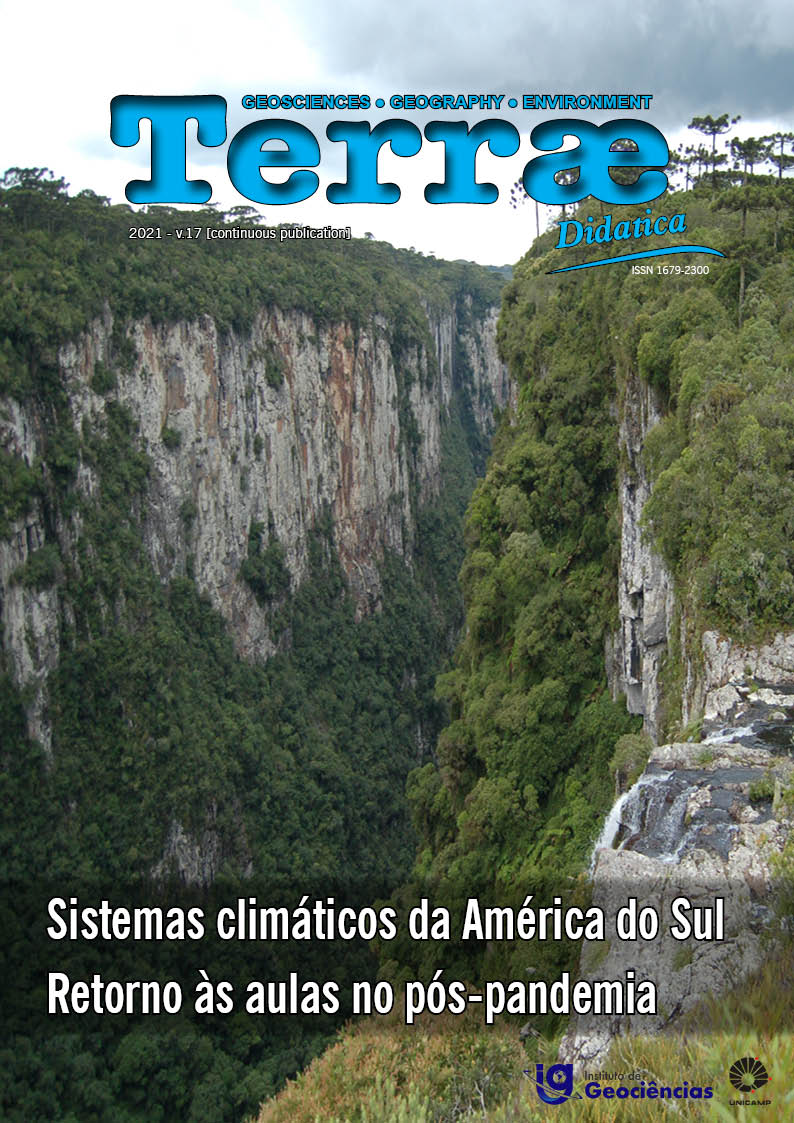Abstract
Sustainable development encompassed a cluster of environmental, social and economic problems, and it is urgent to teach responsible and informed citizens. The holistic view of the Earth System in science education enhances the perception of the role of human being in ecosystems and promotes the environmental awareness essential to sustainable development. This work is a didactic resource for discussion and guided reflection in the teaching of Natural Sciences (8th grade of the elementary school) and Biology and Geology (10th grade of high school) according to the Portuguese curriculum. The Earth System’s innovative approach moves away from the traditional perspective centered on a reductive interpretation of the planet. Sequential and intentional questions and activities are proposed, appropriate to the Sustainability on Earth domain and to chapter I “The Earth and its interacting subsystems" and chapter III "The Earth, a unique planet to be protected”, defined respectively in the 8th and 10th education grade national curriculum.
References
Abrunhosa, M., Chambel, A., Peppoloni, S., & Chaminé, H. I. (2021). Advances in Geoethics and Groundwater Management: Theory and Practice for a Sustainable Development. In: Abrunhosa, M., Chambel, A., Peppoloni, S., & Chaminé, H. I. (Eds). (2021). Proceedings of the 1st Congress on Geoethics and Groundwater Management. Springer. p. 1-523. doi: 10.1007/978-3-030-59320-9.
Assaraf, O. B., & Orion, N. (2005). Development of system thinking skills in the context of Earth System Education. Journal of Research in Science Teaching, 42(5), 518-560. doi: 10.1002/tea.20061.
Barzagli, F., & Mani, F. (2019). The increased anthropogenic gas emissions in the atmosphere and the rising of the Earth’s temperature: are there actions to mitigate the global warming? Substantia, 3(1), 101-111. doi: 10.13128/Substantia-69.
Branco, E. A., Roquetti, D. R., & Moretto, E. M. (2017). O sistema terrestre (land system) como plataforma de integração e interpretação das complexas relações ambiente-sociedade. Sustentabilidade em Debate, 8(3), 111-125. doi: 10.18472/SustDeb.v8n3.2017.24518.
Batzri, O., Assaraf, O. B. Z., Cohen, C., & Orion, N. (2015). Understanding the Earth Systems: Expressions of Dynamic and Cyclic Thinking Among University Students. Journal of Science Education and Technology, 24(6), 761-775. doi: 10.1007/s10956-015-9562-8.
Dias, A. J. G., Freitas, M. C. A. O., Guedes, F., & Bastos, M. C. (2014). Geosfera. Rev. Ciência Elem., 2(1), 107. doi: 10.24927/rce2014.107.
Ellis, C. E. (2015). Ecology in an anthropogenic biosphere. Ecological Monographs, 85(3), 287-331. doi: 10.1890/14-2274.1.
European Space Agency (ESA). (2006). The Changing Earth: New Scientific Challenges for ESA`s Living Planet Programe. European Space Agency, ESA.
Frontier, S. (2001). Os Ecossistemas. Lisboa. Instituto Piaget.
Goodison, B., Brown, J., Jezek, K., Key, J., Prowse, T., Snorrason, A., & Worby, T. (2007). Presente y futuro de la criosfera polar, incluyendo la variabilidad del ciclo hidrológico ártico. Boletín de la OMM, 56(4), 284-292.
Hoffman, M., & Barstow, D. (2007). Revolutionizing Earth System Science Education for the 21st Century. Report and Recommendations from a 50-State Analysis of Earth Science Education Standards. Cambridge. TERC, Center for Earth and Space Science Education.
Intergovernmental Panel on Climate Change (IPCC). (2019). Summary for Policymakers. In: IPCC Special Report on the Ocean and Cryosphere in a Changing Climate [Potner, H. O., Roberts, D. C., Masson-Delmotte, V., Zhai, P., Tignor, M., Poloczanska, E., Mintenbeck, K., Nicolai, M., Okem, A., Petzold, J., Rama, B., & Weyer, N. (Eds.)]. (no prelo).
Latorre, M. L., Júnior, O. A. D. C, Carvalho, A. P. F. D., & Shimabukuro, Y. E. (2002). Correção atmosférica: conceitos e fundamentos. Espaç. Geogr., 5(1), 153-178.
Lévêque, C. (2002). Ecologia: do Ecossistema à Biosfera. Instituto Piaget. Lisboa.
Monteiro, A. F. M., Yamamoto, A. L. C., Silva, P. N., & Reboita, M. S. (2021). Conhecer a complexidade do sistema climático para entender as mudanças climáticas. Terræ Didatica, 17, 1-12. doi: 10.20396/td.vl7i00.8663763.
Moreira, C. (2015). Biosfera. Rev. Ciência Elem., 3(2),113. doi: 10.24927/rce2015.113.
Oliveira, M. J. C., Barbosa, R., Carneiro C. D. R., & Nobre, H. M. (2021). Comunicação pública da Ciência diante das coalizões em conflito sobre aquecimento global. Terræ Didatica, 17, 1-13. doi: 10.20396/td.v17i0.8663967.
Orion, N. (2007). A Holistic Approach for Science Education For All. Eurasia Journal of Mathematics, Science & Technology Education, 3(2), 99-106. doi: 10.12973/ejmste/75382.
Orion, N. (2019). The future challenge of Earth science education research. Disciplinary and Interdisciplinary Science Education Research,1(3), 1-8. doi: 10.1186/s43031-019-0003-z.
Ribeiro, T., Cardoso, A., Silva, J., Lima, D., & Vasconcelos, C. (2021). Chamadas de Geoética: Um Módulo Interativo para Comunicar Geociências. In: Abrunhosa, M., Chambel, A., Peppoloni, S., & Chaminé, H. I. (Eds.). (2021). Advances in Geoethics and Groundwater Management: Theory and Practice for a Sustainable Development. Springer. p. 363-366.
Silveira, L. M. da, & Petrini, M. (2018). Desenvolvimento Sustentável e Responsabilidade Social Corporativa: uma análise bibliométrica da produção científica internacional. Gestão & Produção, 25(1), 56-67. doi: 10.1590/0104-530x3173-16
Sterling, S. (2010). Living in the Earth: Towards an Education for Our Tim. Journal of Education for Sustainable Development, 4 (2), 213-218. doi: 10.1177/097340821000400208.
Stroeve, J. C., Kattsov, V., Barrett, A., Serreze, M., Pavlova, T., Holland, M. & Meier, W. N. (2012). Trends in Arctic sea ice extent from CMIP5, CMIP3 and observations. Geophysical Research Letters, 39 (16). doi: 10.1029/2012gl052676.
Summons, R. E. (1993). Biogeochemical cycles. In: Engel, M. H., & Macko, S. A. (Eds.), Organic Geochemistry (pp. 3-21). Springer.
Tundisi, J. G. (2003). Ciclo hidrológico e gerenciamento integrado. Cien. Cult., 55 (4), 31-33.
UNenvironmentprograme (2020). Coronavirus outbreak highlights need to address threats to ecosystems and wildlife. United Nations. UNEP. URL: https://www.unep.org/news-and-stories/story/coronavirus-outbreak-highlights-need-address-threats-ecosystems-and-wildlife Acesso 3.03.2021
United Nations. (1987). Report of the Word Commission on Environnment and Development: Our Common Future. United Nations.
Vasconcelos, C., & Orion, N. (2021). The Earth sciences education as a key component of the education for sustainability. Sustainability, 13(3), 1316. doi: 10.3390/su13031316.
Wohlleben, P. A. (2019). Sabedoria Secreta da Natureza. Lisboa. Ed. Pergaminho.

This work is licensed under a Creative Commons Attribution-NonCommercial 4.0 International License.
Copyright (c) 2021 Terrae Didatica


